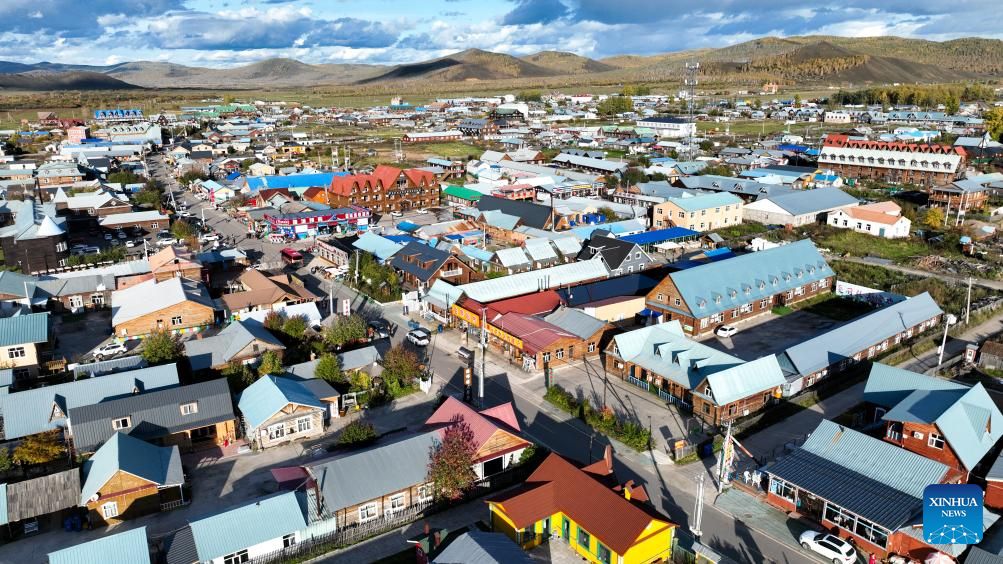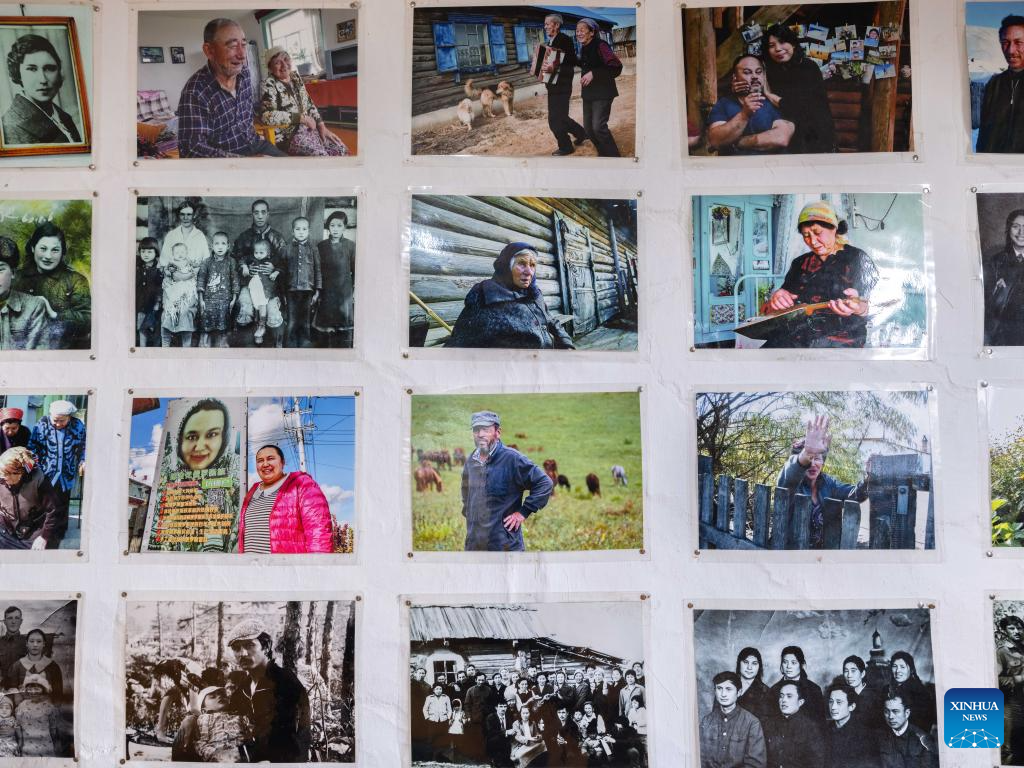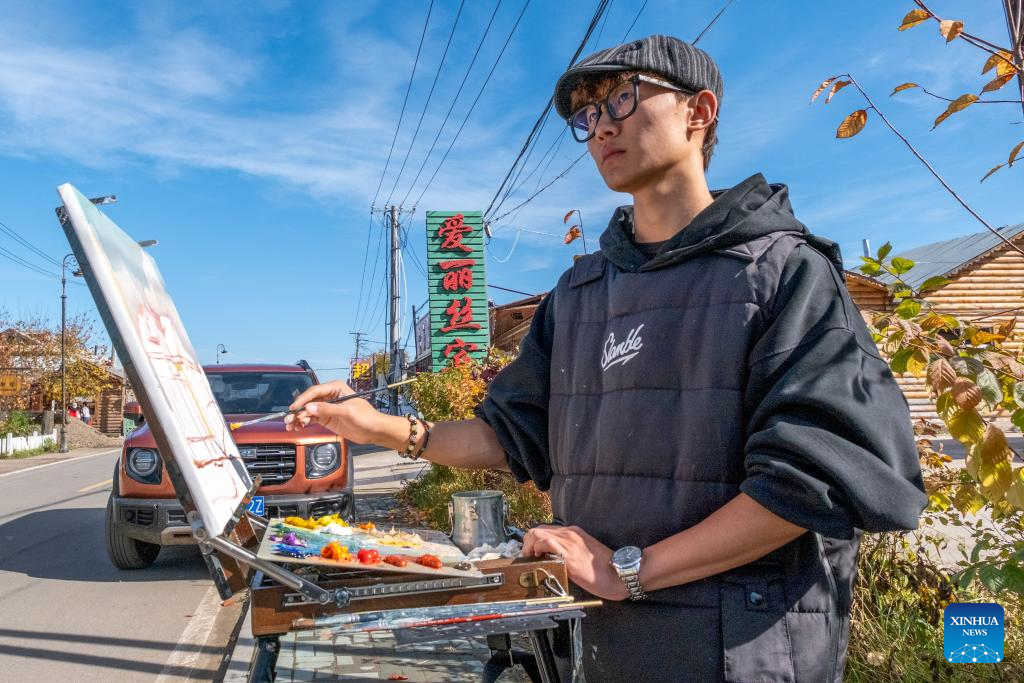Enhe Village in China's Inner Mongolia draws tourists with blend of Chinese-Russian culture
新華網(wǎng)
Editor: huaxia
2025-10-03 16:32:06

Chefs make traditional dishes at a restaurant in Enhe Village of Hulun Buir, north China's Inner Mongolia Autonomous Region, Sept. 26, 2025.
Enhe, a Russian ethnic township in the northeastern corner of Inner Mongolia, has for years drawn travelers seeking its inspiring blend of Chinese-Russian culture, hearty cuisine and sweeping natural vistas.
In recent years, Enhe has developed its tourism industry by promoting unique activities such as local family visiting, Russian bread making and Matryoshka doll painting.
In 2013, the village was listed in the second batch of traditional Chinese villages catalog, sharing its diverse cultures with warmth and inclusiveness. (Xinhua/Ma Jinrui)

People have dinner at a restaurant built from traditional log houses in Enhe Village of Hulun Buir, north China's Inner Mongolia Autonomous Region, Sept. 25, 2025.
Enhe, a Russian ethnic township in the northeastern corner of Inner Mongolia, has for years drawn travelers seeking its inspiring blend of Chinese-Russian culture, hearty cuisine and sweeping natural vistas.
In recent years, Enhe has developed its tourism industry by promoting unique activities such as local family visiting, Russian bread making and Matryoshka doll painting.
In 2013, the village was listed in the second batch of traditional Chinese villages catalog, sharing its diverse cultures with warmth and inclusiveness. (Xinhua/Ma Jinrui)

A drone photo taken on Sept. 17, 2025 shows tourists riding motorcycles in Enhe Village of Hulun Buir, north China's Inner Mongolia Autonomous Region.
Enhe, a Russian ethnic township in the northeastern corner of Inner Mongolia, has for years drawn travelers seeking its inspiring blend of Chinese-Russian culture, hearty cuisine and sweeping natural vistas.
In recent years, Enhe has developed its tourism industry by promoting unique activities such as local family visiting, Russian bread making and Matryoshka doll painting.
In 2013, the village was listed in the second batch of traditional Chinese villages catalog, sharing its diverse cultures with warmth and inclusiveness. (Xinhua/Bei He)

Tourists paint Matryoshka dolls in Enhe Village of Hulun Buir, north China's Inner Mongolia Autonomous Region, Sept. 17, 2025.
Enhe, a Russian ethnic township in the northeastern corner of Inner Mongolia, has for years drawn travelers seeking its inspiring blend of Chinese-Russian culture, hearty cuisine and sweeping natural vistas.
In recent years, Enhe has developed its tourism industry by promoting unique activities such as local family visiting, Russian bread making and Matryoshka doll painting.
In 2013, the village was listed in the second batch of traditional Chinese villages catalog, sharing its diverse cultures with warmth and inclusiveness. (Xinhua/Ma Jinrui)

A drone photo taken on Sept. 17, 2025 shows an exterior view of a bar built from traditional log houses in Enhe Village of Hulun Buir, north China's Inner Mongolia Autonomous Region.
Enhe, a Russian ethnic township in the northeastern corner of Inner Mongolia, has for years drawn travelers seeking its inspiring blend of Chinese-Russian culture, hearty cuisine and sweeping natural vistas.
In recent years, Enhe has developed its tourism industry by promoting unique activities such as local family visiting, Russian bread making and Matryoshka doll painting.
In 2013, the village was listed in the second batch of traditional Chinese villages catalog, sharing its diverse cultures with warmth and inclusiveness. (Xinhua/Bei He)

A drone photo taken on Sept. 17, 2025 shows a view of Enhe Village of Hulun Buir, north China's Inner Mongolia Autonomous Region.
Enhe, a Russian ethnic township in the northeastern corner of Inner Mongolia, has for years drawn travelers seeking its inspiring blend of Chinese-Russian culture, hearty cuisine and sweeping natural vistas.
In recent years, Enhe has developed its tourism industry by promoting unique activities such as local family visiting, Russian bread making and Matryoshka doll painting.
In 2013, the village was listed in the second batch of traditional Chinese villages catalog, sharing its diverse cultures with warmth and inclusiveness. (Xinhua/Bei He)

This photo taken on Sept. 17, 2025 shows file photos displayed at a museum in Enhe Village of Hulun Buir, north China's Inner Mongolia Autonomous Region.
Enhe, a Russian ethnic township in the northeastern corner of Inner Mongolia, has for years drawn travelers seeking its inspiring blend of Chinese-Russian culture, hearty cuisine and sweeping natural vistas.
In recent years, Enhe has developed its tourism industry by promoting unique activities such as local family visiting, Russian bread making and Matryoshka doll painting.
In 2013, the village was listed in the second batch of traditional Chinese villages catalog, sharing its diverse cultures with warmth and inclusiveness. (Xinhua/Ma Jinrui)

Tourists visit Enhe Village of Hulun Buir, north China's Inner Mongolia Autonomous Region, Sept. 18, 2025.
Enhe, a Russian ethnic township in the northeastern corner of Inner Mongolia, has for years drawn travelers seeking its inspiring blend of Chinese-Russian culture, hearty cuisine and sweeping natural vistas.
In recent years, Enhe has developed its tourism industry by promoting unique activities such as local family visiting, Russian bread making and Matryoshka doll painting.
In 2013, the village was listed in the second batch of traditional Chinese villages catalog, sharing its diverse cultures with warmth and inclusiveness. (Xinhua/Bei He)

Tourists enjoy traditional dishes in Enhe Village of Hulun Buir, north China's Inner Mongolia Autonomous Region, Sept. 18, 2025.
Enhe, a Russian ethnic township in the northeastern corner of Inner Mongolia, has for years drawn travelers seeking its inspiring blend of Chinese-Russian culture, hearty cuisine and sweeping natural vistas.
In recent years, Enhe has developed its tourism industry by promoting unique activities such as local family visiting, Russian bread making and Matryoshka doll painting.
In 2013, the village was listed in the second batch of traditional Chinese villages catalog, sharing its diverse cultures with warmth and inclusiveness. (Xinhua/Ma Jinrui)

A student paints outdoors in Enhe Village of Hulun Buir, north China's Inner Mongolia Autonomous Region, Sept. 26, 2025.
Enhe, a Russian ethnic township in the northeastern corner of Inner Mongolia, has for years drawn travelers seeking its inspiring blend of Chinese-Russian culture, hearty cuisine and sweeping natural vistas.
In recent years, Enhe has developed its tourism industry by promoting unique activities such as local family visiting, Russian bread making and Matryoshka doll painting.
In 2013, the village was listed in the second batch of traditional Chinese villages catalog, sharing its diverse cultures with warmth and inclusiveness. (Xinhua/Ma Jinrui)

Huang Yanhong, a retired travel journalist, plays accordion for tourists in Enhe Village of Hulun Buir, north China's Inner Mongolia Autonomous Region, Sept. 26, 2025.
Enhe, a Russian ethnic township in the northeastern corner of Inner Mongolia, has for years drawn travelers seeking its inspiring blend of Chinese-Russian culture, hearty cuisine and sweeping natural vistas.
In recent years, Enhe has developed its tourism industry by promoting unique activities such as local family visiting, Russian bread making and Matryoshka doll painting.
In 2013, the village was listed in the second batch of traditional Chinese villages catalog, sharing its diverse cultures with warmth and inclusiveness. (Xinhua/Ma Jinrui)

Tourists participate in a bonfire party in Enhe Village of Hulun Buir, north China's Inner Mongolia Autonomous Region, Sept. 17, 2025.
Enhe, a Russian ethnic township in the northeastern corner of Inner Mongolia, has for years drawn travelers seeking its inspiring blend of Chinese-Russian culture, hearty cuisine and sweeping natural vistas.
In recent years, Enhe has developed its tourism industry by promoting unique activities such as local family visiting, Russian bread making and Matryoshka doll painting.
In 2013, the village was listed in the second batch of traditional Chinese villages catalog, sharing its diverse cultures with warmth and inclusiveness. (Xinhua/Bei He)

An aerial drone photo taken on Sept. 17, 2025 shows tourists riding horses in Enhe Village of Hulun Buir, north China's Inner Mongolia Autonomous Region.
Enhe, a Russian ethnic township in the northeastern corner of Inner Mongolia, has for years drawn travelers seeking its inspiring blend of Chinese-Russian culture, hearty cuisine and sweeping natural vistas.
In recent years, Enhe has developed its tourism industry by promoting unique activities such as local family visiting, Russian bread making and Matryoshka doll painting.
In 2013, the village was listed in the second batch of traditional Chinese villages catalog, sharing its diverse cultures with warmth and inclusiveness. (Xinhua/Bei He)

This photo taken on Sept. 17, 2025 shows an interior view of a bar built from traditional log houses in Enhe Village of Hulun Buir, north China's Inner Mongolia Autonomous Region.
Enhe, a Russian ethnic township in the northeastern corner of Inner Mongolia, has for years drawn travelers seeking its inspiring blend of Chinese-Russian culture, hearty cuisine and sweeping natural vistas.
In recent years, Enhe has developed its tourism industry by promoting unique activities such as local family visiting, Russian bread making and Matryoshka doll painting.
In 2013, the village was listed in the second batch of traditional Chinese villages catalog, sharing its diverse cultures with warmth and inclusiveness. (Xinhua/Ma Jinrui)

Tourists ride horses in Enhe Village of Hulun Buir, north China's Inner Mongolia Autonomous Region, Sept. 17, 2025.
Enhe, a Russian ethnic township in the northeastern corner of Inner Mongolia, has for years drawn travelers seeking its inspiring blend of Chinese-Russian culture, hearty cuisine and sweeping natural vistas.
In recent years, Enhe has developed its tourism industry by promoting unique activities such as local family visiting, Russian bread making and Matryoshka doll painting.
In 2013, the village was listed in the second batch of traditional Chinese villages catalog, sharing its diverse cultures with warmth and inclusiveness. (Xinhua/Bei He)

A drone photo taken on Sept. 17, 2025 shows tourists riding horses in Enhe Village of Hulun Buir, north China's Inner Mongolia Autonomous Region.
Enhe, a Russian ethnic township in the northeastern corner of Inner Mongolia, has for years drawn travelers seeking its inspiring blend of Chinese-Russian culture, hearty cuisine and sweeping natural vistas.
In recent years, Enhe has developed its tourism industry by promoting unique activities such as local family visiting, Russian bread making and Matryoshka doll painting.
In 2013, the village was listed in the second batch of traditional Chinese villages catalog, sharing its diverse cultures with warmth and inclusiveness. (Xinhua/Bei He)

Tourists make lieba, a type of Russian bread in Enhe Village of Hulun Buir, north China's Inner Mongolia Autonomous Region, Sept. 17, 2025.
Enhe, a Russian ethnic township in the northeastern corner of Inner Mongolia, has for years drawn travelers seeking its inspiring blend of Chinese-Russian culture, hearty cuisine and sweeping natural vistas.
In recent years, Enhe has developed its tourism industry by promoting unique activities such as local family visiting, Russian bread making and Matryoshka doll painting.
In 2013, the village was listed in the second batch of traditional Chinese villages catalog, sharing its diverse cultures with warmth and inclusiveness. (Xinhua/Bei He)

A tourist rides a horse in Enhe Village of Hulun Buir, north China's Inner Mongolia Autonomous Region, Sept. 17, 2025.
Enhe, a Russian ethnic township in the northeastern corner of Inner Mongolia, has for years drawn travelers seeking its inspiring blend of Chinese-Russian culture, hearty cuisine and sweeping natural vistas.
In recent years, Enhe has developed its tourism industry by promoting unique activities such as local family visiting, Russian bread making and Matryoshka doll painting.
In 2013, the village was listed in the second batch of traditional Chinese villages catalog, sharing its diverse cultures with warmth and inclusiveness. (Xinhua/Bei He)

Villagers take a rest outside a traditional log house in Enhe Village of Hulun Buir, north China's Inner Mongolia Autonomous Region, Sept. 18, 2025.
Enhe, a Russian ethnic township in the northeastern corner of Inner Mongolia, has for years drawn travelers seeking its inspiring blend of Chinese-Russian culture, hearty cuisine and sweeping natural vistas.
In recent years, Enhe has developed its tourism industry by promoting unique activities such as local family visiting, Russian bread making and Matryoshka doll painting.
In 2013, the village was listed in the second batch of traditional Chinese villages catalog, sharing its diverse cultures with warmth and inclusiveness. (Xinhua/Bei He)



